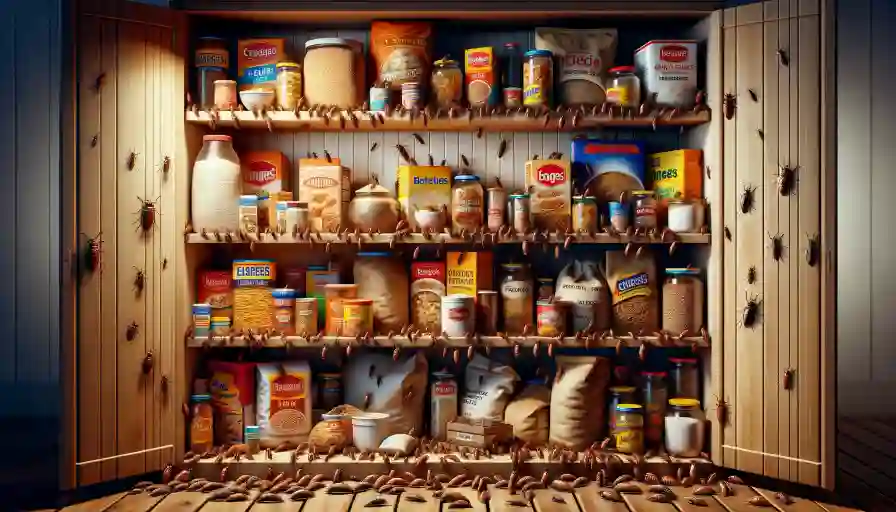Did you find moths in your flour or beetles in your wheat berries? Don’t panic. The bugs in food pantry are typically due to eggs in dried goods, such as flour, which later hatch in your pantry.
What Are the Tiny Bugs in Pantry Food?
Where there is food, there might be critters—bugs like to eat just as we do. The most common pantry bugs are moths, weevils, and small beetles. Yes, they are annoying, but not really dangerous—they won’t bite or sting, nor will they damage your home.
Bugs in Food Pantry

Bugs in the food pantry generally have to do with the presence of insects in places where you store food. It could be your kitchen pantry or cupboard. These bugs might include weevils, moths, beetles, or ants, which are attracted to and often feed on stored food products like flour, grains, nuts, and dried fruits. Their presence can lead to food spoilage and contamination, making the food unsafe to eat.
Your kitchen may be clean but pantry bugs can make themselves at home in even the most spotless kitchen. They often hitch a ride in your food at the grocery store, during delivery, or even way back at the processing plant or warehouse.
Should You Be Worried if You See Bugs in Your Pantry?
If you come across a beetle or two in an area where you don’t store food, it’s probably no cause for alarm — especially if the weather is warm (that’s when bugs flourish). But if you see them on the counter or floor near your pantry, or by a window (or other natural light source), it could be an early sign of infestation. It’s time to take a thorough look at your pantry shelves and packages.
What Foods Attract Pantry Bugs?

Most pantry pests like to munch on grains, like flour, cereals, and processed foods, as well as dried fruits, beans, nuts, and spices—but they’re not picky. Nearly any dried food that is stored at room temperature can be a draw.
Opened packages that aren’t sealed well are especially prime targets because they allow easy entry, but many insects can get into unopened packages as well.
What to Do if You Have Pantry Bugs?
Let’s say you have bugs in your rice box. Dispose of the box, and then check the packages stored near it. If you can’t see the bottom of a bag, consider pouring the food onto a baking sheet and checking it with a flashlight.
If you don’t spot anything in the other packages or around the pantry, the bug was likely an isolated incident and your other foods are fine to keep. If you want to be extra cautious, freeze any potentially affected products for 3 to 4 days, or heat them in an oven at 140 degrees F for an hour or two to kill any eggs or insects.
How to Get Rid of Bugs in Food Pantry

- Start by emptying your entire pantry. Use a vacuum to clean shelves, floors, and corners.
- Next, wash these areas with soapy water. Remember, it’s not advised to use bleach, ammonia, or pesticides. These substances won’t prevent future infestations and can be harmful if they contact with food.
- Before restocking, ensure all food packages are intact and free from contamination.
What Happens if You Eat a Pantry Bug?
If you discover a bug in your food after eating, don’t panic at all. Pantry pests, like the ones you might find in breadcrumbs or pasta, aren’t toxic. Consuming a small bug accidentally is generally harmless.
How Do You Keep Pantry Bugs Away?

To keep pantry bugs away, follow these common practices:
- Buy only as much food as you can use in two to four months.
- Choose packages without damage like dents or holes.
- Practice rotating your stock – use older items first.
- Store grains, cereals, nuts, and dried fruits in airtight containers made of glass, metal, or strong plastic. Cardboard, paper, or foil packaging isn’t very protective against insects.
- When you have goods such as flour, store them in the freezer for some time, usually a few days to a couple of weeks before transferring them to the pantry. Freezing can kill the larvae and prevent them from hatching.
- Keep your pantry essentials in a cool, dry, and dark area.
- Clean your pantry thoroughly every 3 to 6 months to maintain order and deter pests.
Conclusion—Bugs in Food Pantry
Cereal products such as flour, cake mix, cornmeal, rice, spaghetti, crackers, and cookies, as well as seeds (dried beans and popcorn), nuts, chocolate, raisins and other dried fruits, spices, powdered milk, tea, and cured meats, are all susceptible to pantry bugs. These bugs can also infest items such as birdseed, dry pet food, ornamental corn, dried flowers and plants, garden seeds, potpourri, and rodent baits.
Pantry bugs usually invade products with openings, but they can also enter unopened items. They can breach paper, thin cardboard, and packages wrapped in plastic, foil, or cellophane. They might chew through packaging or slip in through folds and seams.
Once insects infest a package, they can rapidly increase in number and spread to other stored foods, not just in the same area but also in other rooms of a house. In an infested product, you might find all stages of insect life — eggs, larvae, pupae, and adults.
Read also: I Wake Up with Bug Bites but My Husband Does Not

![My friend has bed bugs and sat in my car [what to do] My friend has bed bugs and sat in my car [what to do]](https://fodcas.com/wp-content/uploads/2023/04/PicsArt_04-19-09.07.33.webp)
